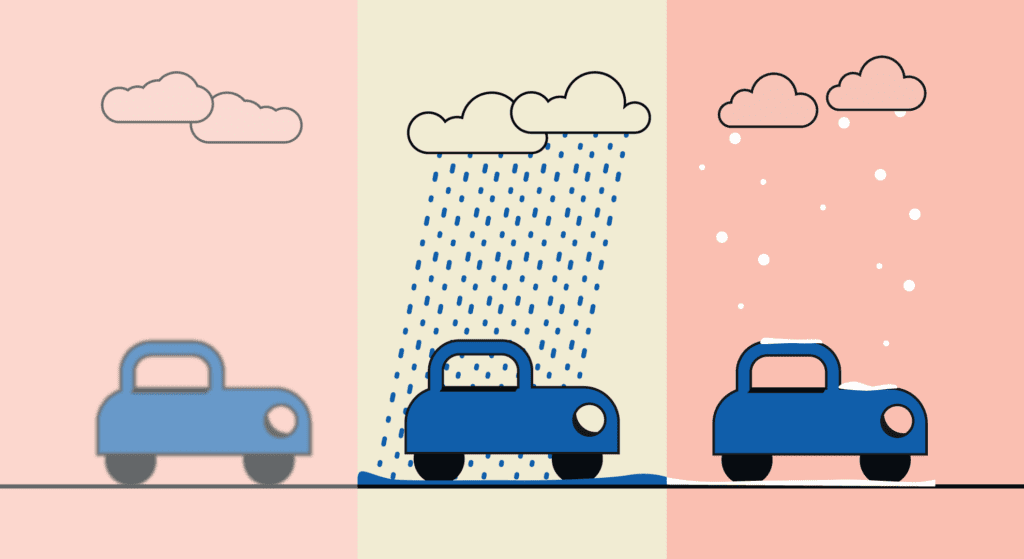Driving can be a nerve-wracking experience for young people in the UK, especially once they’ve passed their test and started driving solo. It’s easy to fret about adverse weather, unfamiliar roads, and having to abide by the Highway Code. Periods of isolation resulting from the COVID-19 pandemic can also knock a driver’s confidence.
Adrian Flux surveyed drivers aged 17-24 to get a better understanding of what factors boost and diminish their confidence on the road. We found that:
- 35% of young drivers felt unconfident driving in snow, while 48% felt unconfident in ice.
- 77% agreed that having points on their license would make them “more” or “very” cautious.
- 53.3% thought that driving every day was an effective way to build confidence.
Read more about our findings below and learn how young drivers can mitigate common issues and boost their self-assurance in the future.
Common confidence drains
Lesser-travelled roads
Not all roads are made equal. According to the DfT, unfamiliar road layouts played a part in 1,407 accidents in 2020. Among our survey respondents, the road type that inspired the least confidence was also the one that drivers tend to encounter least frequently: country lanes. Some 15% of respondents described themselves as unconfident on this road type, while 16% described themselves as neither confident nor unconfident.

Wintry weather
When the temperature falls, UK roads can become treacherous. Between November and March, sleet, rain, fog, snow, and ice can combine with windy conditions to heighten the chance of accidents.
For younger drivers, the changing weather can affect confidence. Just over a third of the people we surveyed (34%) said they were unconfident in general wintry conditions, which rises to 35% when snow is involved and 48% when the roads are icy.
Figures from the Department for Transport (DfT) suggest these concerns are well-founded. In 2020, rain, sleet, snow, or fog accounted for 1,330 accidents on British roads. Of external factors affecting driver vision, this was only surpassed by stationary or parked vehicles (1,437) and dazzling sun (1,849).

While it’s impossible to fully offset the risks of driving in poor weather, you can find some practical tips in our guide to driving in snowy conditions and our guide to driving in the rain and standing water.
Boosting confidence with a black box
Rightly or wrongly, younger drivers have a reputation for engaging in risky driving behaviours such as speeding and using a phone at the wheel. It’s an unfair reality that even careful young drivers feel the burden of this stereotype. Nowhere is this clearer than with car insurance: the higher premiums offered to young people can be a blow to their confidence on the road.
Young people who want to shed this stereotype should consider installing a telematics device such as a black box. These devices collect data about a driver, including average speed, distance covered and the usual times driving takes place. Equipped with this data, the black box user can get a better idea about the safety of their driving. Insurance providers can, too, which allows them to offer a lower premium.
Our survey results suggest that a black box can boost the confidence of younger drivers, particularly in wintry conditions. Some 30% of respondents using a black box said they were unconfident driving in snowy conditions, which is 13% less than those who have never used one. Similarly, 41% of young drivers with black boxes installed said they were unconfident driving in ice – 16% less than those without.

Black Boxes can alert emergency services if they detect a major collision. Our FluxScore Black Box car insurance includes an automatic dial-out safety function located within the Black Box itself.
When Ayesha Jenkins lost control in the snow despite travelling at just 10mph on a 30mph road, this functionality was triggered. It immediately put her in touch with an experienced team, who made sure she was okay and spoke with her to assess the seriousness of the incident.
“It was really nice to have someone there to speak to as soon as it happened,” the 18-year-old said. “It’s definitely a technology that can save lives. Mine wasn’t a serious accident, but if someone is unconscious after a crash with this Black Box in the car, someone is going to know.”
This package also includes daily weather updates delivered via a smartphone app, alerting you to hazardous driving conditions – such as sleet or black ice – within a three-mile grid around your car.
Beyond the textbook
The overwhelming majority (96.9%) of survey respondents agreed that the UK driving test is an effective measure of driver confidence across a wide variety of situations.
However, some respondents indicated that they didn’t feel prepared for everything, even after passing. One young driver felt that adverse weather conditions weren’t adequately covered, while others had concerns about the role of luck on test day.
A theme among answers was that real-world experience is necessary alongside the textbook knowledge necessary for passing the test. It’s unavoidable that new drivers lack this experience, but as they spend more time on the road and expose themselves to more situations, they will gradually improve their skills.
Top tips to improve driver confidence
- Know your vehicle. Before you set off on your journey, it’s important to know the ins and outs of your vehicle. Familiarise yourself with how to turn the windscreen wiper on, and the locations of the indicator and hazard lights. You’ll also need to know how to effectively clear condensation, mist or ice off the windscreen before setting off.
- Purchase insurance that caters to your needs. Your car insurance should be affordable and cater to your needs. Our new driver insurance can be tailored to your specific needs, with benefits including total loss protection, protected no-claims bonus and a limited mileage policy to reduce your premium.
- Stick to speeding limits. To reduce the risk of accident, adhering to speed limits is essential. If you don’t, you could risk a fine, penalty or even a driving ban. Black box devices can ensure you remain on the right path.
- Challenge yourself by visiting new destinations: Getting out of your comfort zone and travelling new routes will further your confidence in driving in unfamiliar territory and will help develop your driving skills.
- Take an advanced driving course: If you have recently passed your driving test, completing an advanced course could improve your confidence and skills. Completing courses such as PassPlus and IAM can also lead to a reduction in your premium by up to 25% and lead to cheaper insurance.
Summary
It’s clear that many young drivers suffer from a loss in confidence when conditions are suboptimal. However, that’s understandable when you consider that poor weather and unfamiliar roads may not have featured in their driving lessons and test. When you add unfavourable stereotypes into the mix – and inflated insurance premiums – the self-doubt within this demographic makes even more sense.
Fortunately, there are solutions. Beyond the tried-and-tested formula of spending more time on the road and accruing useful experience, young drivers can assess their own safety by taking advantage of Black Box insurance packages. By looking at the data and taking heed of feedback from the FluxScore app, drivers can gain a more objective perspective on their performance. Given enough time, confidence will surely follow.
Get black box insurance with Adrian Flux
If you’re a young driver looking to save money while boosting your confidence, check out our FluxScore black box car insurance, which can reduce renewal premiums by up to 60%. Call us for a quote on 0800 369 8590 or book a callback at a time that suits you.

